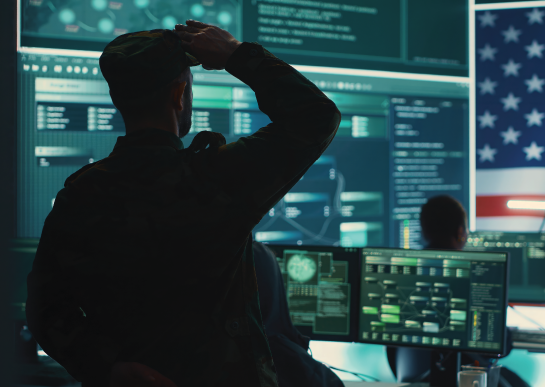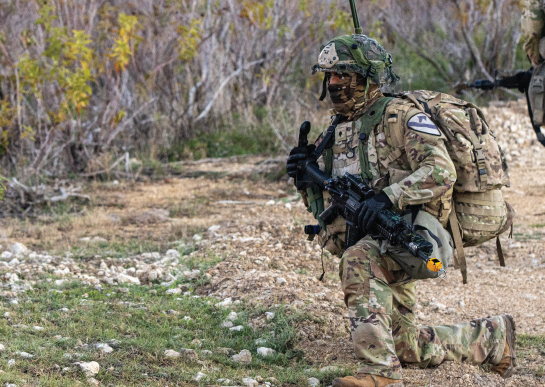Defense S&T Spotlight
July 2024
Defense S&T Spotlight compiles news and updates relevant to DoD and the research and engineering (R&E) community and highlights DTIC resources that will empower you to better analyze, shape, and share your science and technology efforts.
Spotlight Areas
- R&E In The News
- DTIC Products & Services
- DoDIAC
- DTIC Users Council Corner
- Quarterly Features
- News Center
Remember, credentials control the type of information accessible to users.
R&E In The News

Members of the House of Representatives and Senate have inserted language into the annual defense policy bill calling for a study into creating a new military branch that concentrates on the cyber domain. A study published in 2017, already in DTIC's collection, provides analysis on this same topic.
Discover technical reports in DTIC's collection covering Cyber Warfare:
Ignoring a Revolution in Military Affairs: The Need to Create a Separate Branch of the Armed Forces for Cyber Warfare - AD1038566
Bits And Bullets: Cyber Warfare In Military Operations - AD1069530
Cyber Warfare: Protecting Military Systems - ADA487951
Source: WUNC Morning Edition

The Under Secretary of Defense for Research and Engineering (USDR&E) created a new team, the Transition Tracking Action Group (TTAG), to leverage data analytics to track and understand how well new technology makes its way to the warfighter. TTAG is tasked with creating a method to track technology transition and determine the reasons technologies do or do not transition.
Explore more information on the CTAs on DoDTechipedia.
Source: Defense.gov

The Army announced it will buy hundreds of portable electronic warfare attack and scanner systems, dubbed the Terrestrial Layer System-Brigade Combat Team Manpack. The system is designed to scan the electromagnetic spectrum for enemy activity and jam enemy transmissions. It will be fielded this year and is intended to help soldiers learn how to operate in a contested electromagnetic spectrum. Russia and Ukraine have utilized electronic warfare tactics extensively in their ongoing conflict.
Discover technical reports in DTIC's collection covering electronic warfare:
Multi-Domain Electronic Warfare System - AD1230267
Outsmarting Agile Adversaries in the Electromagnetic Spectrum - AD1191104
Information Paper: Joint Electromagnetic Spectrum Operations (JEMSO) - AD1111702
Source: Nextgov.com

The Artificial Intelligence (AI) Defense Technical Review explored the topics of scalability and federation in artificial intelligence.
The event, organized by the Under Secretary of Defense for Research and Engineering (USD(R&E)) featured speakers and experts from various organizations including Google, Microsoft, and Defense Advanced Research Projects Agency (DARPA).
Discussions included practical applications and challenges of federated AI, distributed C2 at the tactical edge, and the future of federated AI in defense.
Significant outcomes included the introduction of the AI Passport concept for multi-party software co-development and the emphasis on designing for modularity and security. The event aimed to inform the development of responsible and ethical use of AI in defense operations.
Explore more information on the CTA: Trusted Artificial Intelligence & Autonomy on DoDTechipedia.
Source: U.S. Department of Defense
DTIC Products & Services

Use your DoD-issued CAC, PIV, or ECA to access DTIC’s R&E Gateway and its extensive collection of controlled-unclassified DoD technical reports and research projects.
Need help signing in or registering? Email DTIC or call 800-225-3842.
A roadblock can delay, or even stop research progress. With the right information available, research momentum can continue and even accelerate.
To assist researchers with maintaining momentum, the Defense Technical Information Center officially launched a new DTIC search function on the R&E Gateway site earlier this year.
DTIC’s reimagined search function enables access to multiple databases through a single, user-friendly interface. Users can swiftly locate what they seek, maximize Research & Development funding, avoid redundant efforts, build upon existing or previous work, and expedite the implementation of vital technology solutions benefiting military personnel.
Among the enhancements are:
- Visualizations that enable a deeper dive into content based on things like area of interest or budget year
- Related terms that aid in refining a search
- Quick filter options for navigating through various collection categories
DTIC will continue introducing new functionalities to enhance search capabilities, making it easier to discover the Department of Defense's scientific and technical research activities throughout the research cycle.
Continue reading by logging into the S&T Spotlight on DoDTechipedia.
The research community relies on credible, findings and data that can be reused to advance scientific progress. DoD Instruction 3200.12 mandates DoD-funded research organizations submit their results to DTIC. The mandate is designed to benefit the scientific and technical community in the following ways:
- Maximize research and development investments and help reduce duplicative efforts
- Accelerate research and engineering innovations
- Ensure preservation and availability of research documents
- Increase the visibility and impact of your research
- Support cooperative efforts across services and domains
Benefit the warfighters of tomorrow by submitting your research today.
Access additional DoD policy documents governing S&T research submissions.

Interested in more like these? Check out DTIC’s collection. If you are not a registered user, please visit DTIC’s registration page to find out more about becoming part of the DTIC community.
DTIC has close to 5 million technical reports and other scientific and technological information in its collection of DoD funded research. Here’s a sampling:
Design and Application of an Adept Aerosol Lung-on-a-Chip and Aerosol and Vapor Delivery Systems
Organ-on-a-chip technology and other microphysiological systems were designed to recreate living tissues that mimic organ microenvironments. Although organ-on-a-chip models correct many gaps traditional tissue cultures present, these systems still suffer limitations. One such limitation, specific to lung-on-a-chip technology is the inability to accurately administer aerosols and vapors to lung epithelial cells. To close the gap, as detailed in their latest paper, the Combat Capabilities Development Command Chemical Biological Center designed, generated, and evaluated a novel open-top chip design specific for the evaluation of aerosol and vapor toxicity and efficacy testing.
Access DTIC’s Collection: AD1229901
Encryption for Edge Computing Applications
Edge computing enables computing resources closer to the source of data generation. The edge can be described at different sources throughout the data processing chain levels including sensor, device, router, data center, cloud, and mobile. The growth of smart sensors and the Internet of Things (IoT) increased the need for processing solutions for sensor node data located in the operational arena. This report prepared by the US Army Engineer Research and Development Center, Information Technology Laboratory details current research about encryption methods in the edge computing space to gain knowledge of established mechanisms, explore emerging methodologies, and highlight challenges associated with implementing effective encryption for computing resources closer to the source of data generation.
Access DTIC’s Collection: AD1228869
High-Value Space Asset Defense and Threat Mitigation
As China continues to advance as a near-peer military competitor with the U.S., the Indo-Pacific Command (INDOPACOM) should be prepared to safeguard critical U.S. networks in a conflict where space is an active and contested domain. In this report, the author outlines areas where the INDOPACOM can and should prepare for a future conflict with China in space by developing a Joint Space Defense Initiative (JSDI) to identify and defend the critical communication areas and datalinks that will protect U.S. warfare in the Pacific Theater.
Access DTIC’s Collection: AD1174719
DoDIAC
The DoD Information Analysis Centers (IAC) DoDIAC develops State-of-the-Art Reports (SOAR) for those interested in advanced technical knowledge who prefer in-depth discussions and want a nuanced analysis of a specific technology, challenge, or solution. Our latest SOAR is a treatise on the use of additive manufacturing processes in the fields of energetics and explosives.
Additive manufacturing (AM) is the process of depositing or fusing material together in a layer‑by‑layer approach, typically in an engineered shape, formation, and/or mixture of materials.
Continue reading by logging into the S&T Spotlight on DoDTechipedia.
Visit DTIC's DoD Information Analysis Centers on the web at www.csiac.org, www.dsiac.org and www.hdiac.org.
DTIC Users Council Corner
- Are you an advocate of DTIC and its products and services?
- Do you have a passion for assisting the S&T and RDT&E communities?
- If so, here is your chance to make a lasting impact by joining the DTIC User Council for FY 2025.
DTIC has four open positions for the FY 2025 DTIC User Council. This is your opportunity to develop professional relationships and offer essential feedback and advice to DTIC on its products and services.
The nomination window is open until Aug. 2. Nominate yourself or a colleague interested in becoming a member of the DTIC User Council for the FY 2025 term.
Note: To cast your vote and select your four representatives. Check your mailbox in August 2024.
Login to learn more about the DTIC User Council, the nomination process, and to complete the nomination package.
Quarterly Features
Access DTIC with a PIV
Accessing the S&T information in DTIC’s database with a government-issued Personal Identity Verification (PIV) card is as easy as 1, 2, 3.
One: Download DoD Root Certificates to your browser before trying to register with DTIC. Your organization's IT personnel can help with that.
Two: Use that same browser to register at DTIC. Your PIV, which DTIC recognizes as a Smart Card, must be connected.
Three: Browse DTIC’s close to 5 million science and technical information documents on DTIC’s R&E Gateway. Because the documents are access controlled, not everyone will be able to view every document.
Senior Principal Chief Scientist for Complex Systems Modeling, MITRE Corporation
Dr. Tolk is Senior Principal Chief Scientist for Complex Systems Modeling within the Modeling and Analysis Innovation Center of The MITRE Corporation. MITRE operates six federally funded research and development centers (FFRDCs) for federal government sponsors, including the National Security Engineering (NSEC) FFRDC that MITRE has operated on the behalf of the Department of Defense (DoD) since 1958. Dr. Tolk, an internationally renowned expert in the disciplines of Modeling and Simulation and Systems Engineering, has contributed significantly to the deeper understanding of interoperability and composability with focus on distributed defense simulation applications. Starting with the challenge of making training simulations interoperable with battle management and command and control systems to enable more realistic training, Tolk extended this research to a wide array of additional applications, including medical simulations, supply chains, and computational policy support. Using the insight of the necessity of conceptual alignment of model-based solutions, he contributed to research on autonomy, cyber-physical systems, system of systems. Learn More
News Center

JDR&E
Volume 7 issue 2 of the Journal of DoD Research and Engineering (JDR&E) is more than 260 pages, the largest issue published to date.
Access the NIPR version of the JDR&E via DoDTechipedia. Remember, credentials control the type of information accessible to users.
The journal staff are seeking additional peer reviewers. Apply to become a JDR&E peer reviewer.
Disclaimers
Featured news articles highlight technology, research, and developments of interest to the S&T and RDT&E communities. Articles may have been abbreviated, synopsized, or excerpted; the full articles can be found by using the links provided within or at the bottom of each article. The views expressed in this online newsletter are those of the originating authors and do not reflect the official policy, position or opinion(s) of the Defense Technical Information Center (DTIC), Department of Defense (DoD), or the United States Government.
DTIC does not endorse any specific technologies, products, or services featured in or highlighted by any of the articles in this online newsletter. The appearance of external hyperlinks does not constitute endorsement by DTIC, the DoD, or the United States Government of the linked websites, or the information, products or services contained therein and neither DTIC, the DoD, nor the United States Government exercises any editorial control over the information you may find at these locations.
All provided links are consistent with the mission of this website.
Please let us know about any existing external links that you believe are inappropriate.









